Zhiwei Xu
Bridging the Capability Gap: Joint Alignment Tuning for Harmonizing LLM-based Multi-Agent Systems
Sep 11, 2025Abstract:The advancement of large language models (LLMs) has enabled the construction of multi-agent systems to solve complex tasks by dividing responsibilities among specialized agents, such as a planning agent for subgoal generation and a grounding agent for executing tool-use actions. Most existing methods typically fine-tune these agents independently, leading to capability gaps among them with poor coordination. To address this, we propose MOAT, a Multi-Agent Joint Alignment Tuning framework that improves agents collaboration through iterative alignment. MOAT alternates between two key stages: (1) Planning Agent Alignment, which optimizes the planning agent to generate subgoal sequences that better guide the grounding agent; and (2) Grounding Agent Improving, which fine-tunes the grounding agent using diverse subgoal-action pairs generated by the agent itself to enhance its generalization capablity. Theoretical analysis proves that MOAT ensures a non-decreasing and progressively convergent training process. Experiments across six benchmarks demonstrate that MOAT outperforms state-of-the-art baselines, achieving average improvements of 3.1% on held-in tasks and 4.4% on held-out tasks.
SLIM: Subtrajectory-Level Elimination for More Effective Reasoning
Aug 27, 2025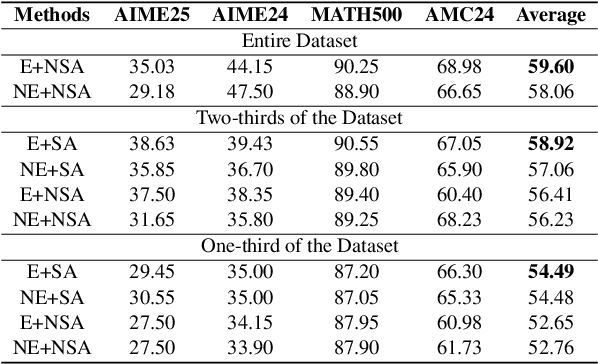
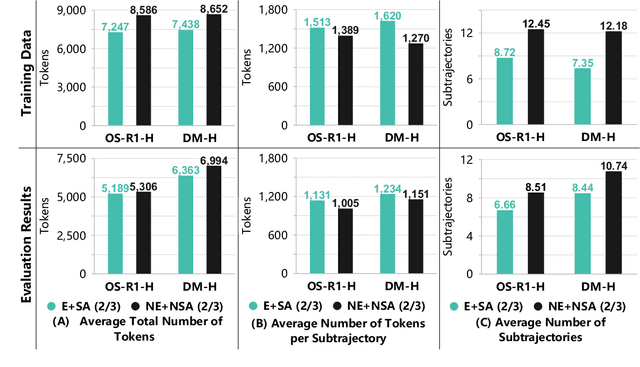
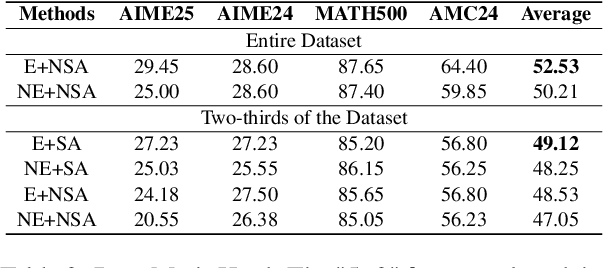
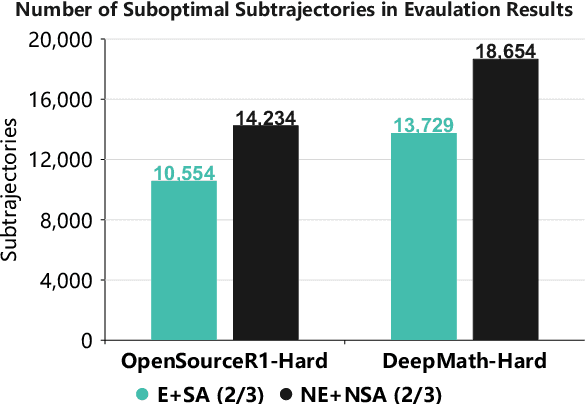
Abstract:In recent months, substantial progress has been made in complex reasoning of Large Language Models, particularly through the application of test-time scaling. Notable examples include o1/o3/o4 series and DeepSeek-R1. When responding to a query, these models generate an extended reasoning trajectory, during which the model explores, reflects, backtracks, and self-verifies before arriving at a conclusion. However, fine-tuning models with such reasoning trajectories may not always be optimal. Our findings indicate that not all components within these reasoning trajectories contribute positively to the reasoning process; in fact, some components may affect the overall performance negatively. In this study, we divide a reasoning trajectory into individual subtrajectories and develop a "5+2" framework to: (1) systematically identify suboptimal subtrajectories within the reasoning trajectory based on five human-established criteria; (2) assess the independence of the suboptimal subtrajectories identified in (1) from the subsequent content, ensuring that their elimination does not compromise overall flow and coherence of the reasoning process. Additionally, a sampling algorithm, built upon the "5+2" framework, is employed to select data whose reasoning process is free from suboptimal subtrajectories to the highest degree. Experimental results demonstrate that our method can reduce the number of suboptimal subtrajectories by 25.9\% during the inference. Furthermore, our method achieves an average accuracy of 58.92\% on highly challenging math benchmarks with only two thirds of training data, surpassing the average accuracy of 58.06\% achieved with the entire data, and outperforming open-source datasets, when fine-tuning Qwen2.5-Math-7B. Finally, We validated our method under resource constraints and observed improved performance across various inference token limits.
Graph of Verification: Structured Verification of LLM Reasoning with Directed Acyclic Graphs
Jun 14, 2025Abstract:Verifying the reliability of complex, multi-step reasoning in Large Language Models (LLMs) remains a fundamental challenge, as existing methods often lack both faithfulness and precision. To address this issue, we propose the Graph of Verification (GoV) framework. GoV offers three key contributions: First, it explicitly models the underlying deductive process as a directed acyclic graph (DAG), whether this structure is implicit or explicitly constructed. Second, it enforces a topological order over the DAG to guide stepwise verification. Third, GoV introduces the notion of customizable node blocks, which flexibly define the verification granularity, from atomic propositions to full paragraphs, while ensuring that all requisite premises derived from the graph are provided as contextual input for each verification unit. We evaluate GoV on the Number Triangle Summation task and the ProcessBench benchmark with varying levels of reasoning complexity. Experimental results show that GoV substantially improves verification accuracy, faithfulness, and error localization when compared to conventional end-to-end verification approaches. Our code and data are available at https://github.com/Frevor/Graph-of-Verification.
NGENT: Next-Generation AI Agents Must Integrate Multi-Domain Abilities to Achieve Artificial General Intelligence
Apr 30, 2025Abstract:This paper argues that the next generation of AI agent (NGENT) should integrate across-domain abilities to advance toward Artificial General Intelligence (AGI). Although current AI agents are effective in specialized tasks such as robotics, role-playing, and tool-using, they remain confined to narrow domains. We propose that future AI agents should synthesize the strengths of these specialized systems into a unified framework capable of operating across text, vision, robotics, reinforcement learning, emotional intelligence, and beyond. This integration is not only feasible but also essential for achieving the versatility and adaptability that characterize human intelligence. The convergence of technologies across AI domains, coupled with increasing user demand for cross-domain capabilities, suggests that such integration is within reach. Ultimately, the development of these versatile agents is a critical step toward realizing AGI. This paper explores the rationale for this shift, potential pathways for achieving it.
Accommodate Knowledge Conflicts in Retrieval-augmented LLMs: Towards Reliable Response Generation in the Wild
Apr 17, 2025Abstract:The proliferation of large language models (LLMs) has significantly advanced information retrieval systems, particularly in response generation (RG). Unfortunately, LLMs often face knowledge conflicts between internal memory and retrievaled external information, arising from misinformation, biases, or outdated knowledge. These conflicts undermine response reliability and introduce uncertainty in decision-making. In this work, we analyze how LLMs navigate knowledge conflicts from an information-theoretic perspective and reveal that when conflicting and supplementary information exhibit significant differences, LLMs confidently resolve their preferences. However, when the distinction is ambiguous, LLMs experience heightened uncertainty. Based on this insight, we propose Swin-VIB, a novel framework that integrates a pipeline of variational information bottleneck models into adaptive augmentation of retrieved information and guiding LLM preference in response generation. Extensive experiments on single-choice, open-ended question-answering (QA), and retrieval augmented generation (RAG) validate our theoretical findings and demonstrate the efficacy of Swin-VIB. Notably, our method improves single-choice task accuracy by at least 7.54\% over competitive baselines.
QLLM: Do We Really Need a Mixing Network for Credit Assignment in Multi-Agent Reinforcement Learning?
Apr 17, 2025



Abstract:Credit assignment has remained a fundamental challenge in multi-agent reinforcement learning (MARL). Previous studies have primarily addressed this issue through value decomposition methods under the centralized training with decentralized execution paradigm, where neural networks are utilized to approximate the nonlinear relationship between individual Q-values and the global Q-value. Although these approaches have achieved considerable success in various benchmark tasks, they still suffer from several limitations, including imprecise attribution of contributions, limited interpretability, and poor scalability in high-dimensional state spaces. To address these challenges, we propose a novel algorithm, \textbf{QLLM}, which facilitates the automatic construction of credit assignment functions using large language models (LLMs). Specifically, the concept of \textbf{TFCAF} is introduced, wherein the credit allocation process is represented as a direct and expressive nonlinear functional formulation. A custom-designed \textit{coder-evaluator} framework is further employed to guide the generation, verification, and refinement of executable code by LLMs, significantly mitigating issues such as hallucination and shallow reasoning during inference. Extensive experiments conducted on several standard MARL benchmarks demonstrate that the proposed method consistently outperforms existing state-of-the-art baselines. Moreover, QLLM exhibits strong generalization capability and maintains compatibility with a wide range of MARL algorithms that utilize mixing networks, positioning it as a promising and versatile solution for complex multi-agent scenarios.
Let Me Grok for You: Accelerating Grokking via Embedding Transfer from a Weaker Model
Apr 17, 2025Abstract:''Grokking'' is a phenomenon where a neural network first memorizes training data and generalizes poorly, but then suddenly transitions to near-perfect generalization after prolonged training. While intriguing, this delayed generalization phenomenon compromises predictability and efficiency. Ideally, models should generalize directly without delay. To this end, this paper proposes GrokTransfer, a simple and principled method for accelerating grokking in training neural networks, based on the key observation that data embedding plays a crucial role in determining whether generalization is delayed. GrokTransfer first trains a smaller, weaker model to reach a nontrivial (but far from optimal) test performance. Then, the learned input embedding from this weaker model is extracted and used to initialize the embedding in the target, stronger model. We rigorously prove that, on a synthetic XOR task where delayed generalization always occurs in normal training, GrokTransfer enables the target model to generalize directly without delay. Moreover, we demonstrate that, across empirical studies of different tasks, GrokTransfer effectively reshapes the training dynamics and eliminates delayed generalization, for both fully-connected neural networks and Transformers.
Focus on Local: Finding Reliable Discriminative Regions for Visual Place Recognition
Apr 14, 2025Abstract:Visual Place Recognition (VPR) is aimed at predicting the location of a query image by referencing a database of geotagged images. For VPR task, often fewer discriminative local regions in an image produce important effects while mundane background regions do not contribute or even cause perceptual aliasing because of easy overlap. However, existing methods lack precisely modeling and full exploitation of these discriminative regions. In this paper, we propose the Focus on Local (FoL) approach to stimulate the performance of image retrieval and re-ranking in VPR simultaneously by mining and exploiting reliable discriminative local regions in images and introducing pseudo-correlation supervision. First, we design two losses, Extraction-Aggregation Spatial Alignment Loss (SAL) and Foreground-Background Contrast Enhancement Loss (CEL), to explicitly model reliable discriminative local regions and use them to guide the generation of global representations and efficient re-ranking. Second, we introduce a weakly-supervised local feature training strategy based on pseudo-correspondences obtained from aggregating global features to alleviate the lack of local correspondences ground truth for the VPR task. Third, we suggest an efficient re-ranking pipeline that is efficiently and precisely based on discriminative region guidance. Finally, experimental results show that our FoL achieves the state-of-the-art on multiple VPR benchmarks in both image retrieval and re-ranking stages and also significantly outperforms existing two-stage VPR methods in terms of computational efficiency. Code and models are available at https://github.com/chenshunpeng/FoL
Large Language Model Guided Self-Debugging Code Generation
Feb 05, 2025Abstract:Automated code generation is gaining significant importance in intelligent computer programming and system deployment. However, current approaches often face challenges in computational efficiency and lack robust mechanisms for code parsing and error correction. In this work, we propose a novel framework, PyCapsule, with a simple yet effective two-agent pipeline and efficient self-debugging modules for Python code generation. PyCapsule features sophisticated prompt inference, iterative error handling, and case testing, ensuring high generation stability, safety, and correctness. Empirically, PyCapsule achieves up to 5.7% improvement of success rate on HumanEval, 10.3% on HumanEval-ET, and 24.4% on BigCodeBench compared to the state-of-art methods. We also observe a decrease in normalized success rate given more self-debugging attempts, potentially affected by limited and noisy error feedback in retention. PyCapsule demonstrates broader impacts on advancing lightweight and efficient code generation for artificial intelligence systems.
Psychometric-Based Evaluation for Theorem Proving with Large Language Models
Feb 02, 2025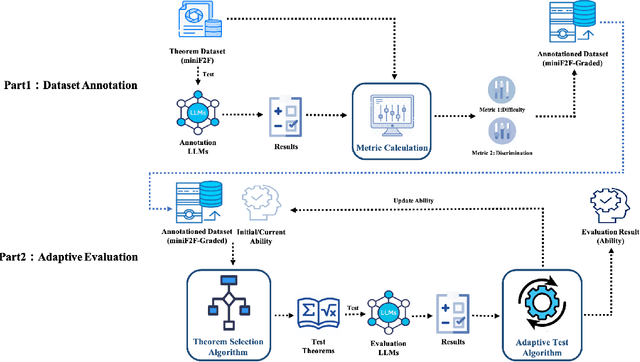

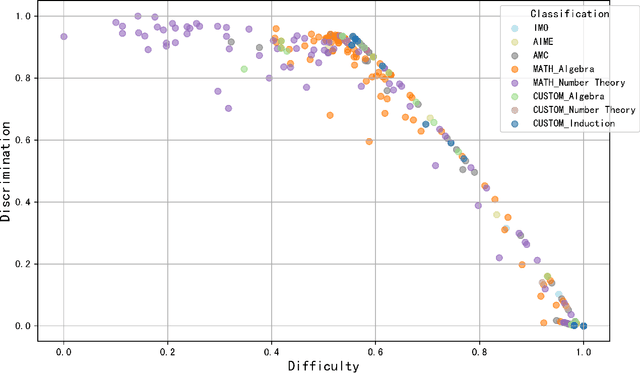

Abstract:Large language models (LLMs) for formal theorem proving have become a prominent research focus. At present, the proving ability of these LLMs is mainly evaluated through proof pass rates on datasets such as miniF2F. However, this evaluation method overlooks the varying importance of theorems. As a result, it fails to highlight the real performance disparities between LLMs and leads to high evaluation costs. This study proposes a psychometric-based evaluation method for theorem proving with LLMs, comprising two main components: Dataset Annotation and Adaptive Evaluation. First, we propose a metric calculation method to annotate the dataset with difficulty and discrimination metrics. Specifically, we annotate each theorem in the miniF2F dataset and grade them into varying difficulty levels according to the performance of LLMs, resulting in an enhanced dataset: miniF2F-Graded. Experimental results show that the difficulty grading in miniF2F-Graded better reflects the theorem difficulty perceived by LLMs. Secondly, we design an adaptive evaluation method to dynamically select the most suitable theorems for testing based on the annotated metrics and the real-time performance of LLMs. We apply this method to evaluate 10 LLMs. The results show that our method finely highlights the performance disparities between LLMs. It also reduces evaluation costs by using only 23% of the theorems in the dataset.
 Add to Chrome
Add to Chrome Add to Firefox
Add to Firefox Add to Edge
Add to Edge